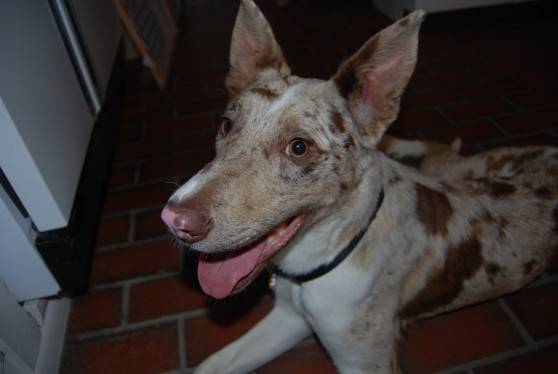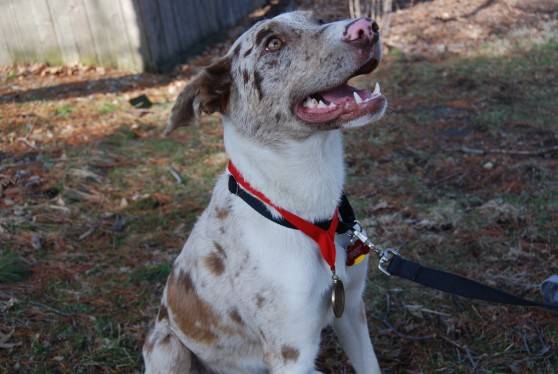OK, OK. No, I did not get a turtle from the Champaign County Humane Society, and no I did not drag it on my run. You can stop sending me the hate mail.
No, I got a new dog. My wife and I have been thinking about it off and on for the past couple of months, and we would visit the Humane Society’s website once a week or so. The other day we finally decided to “just have a look” and visit the dogs at the shelter. We have one dog already, and it was coming up on the one-year anniversary since putting down our other elderly dog. It was time to find a new friend. We weren’t thinking we’d find the dog on the first trip, but sometimes, things are just meant to be.
Being the runner that I am, I wanted to find a running buddy. Pearl, our current dog, isn’t much of a running partner. Being the scent hound that she is, she’s more interested in what is on the ground than what is in front of her. I wanted a dog that would be sleek, svelte, and made for speed. Or, at least, easier to handle on a run.
Enter Jackaroo.

The Humane Society thinks that he is an Australian shepherd mix. Based on his herding skills, he’s a shepherd for sure, but he also has the body of a running dog, like a sighthound. Elegant stride, long gait, and smooth pace. Whatever he is, a Catahoula Cur or something else, (maybe even a Chupacabra), he’s got running in his blood.
I’ve got a few friends who run with dogs, and they always seem to have a good time on the road. It got me to thinking, what are some things you need to consider when “training” your dog to run? People think of their dogs as their pals, and when they’re running, they’re just another part of the pack. But, if a dog is an athlete, too, do they suffer the same running injuries we do? How far is too far to run a dog? Do they need a special training routine?
I asked two friends about their experience running with dogs. They also happen to be veterinarians. Ken Welle, of Urbana, is an avian and exotic pet veterinarian with the Veterinary Teaching Hospital at the University of Illinois. His dog is Cayenne (eight years old). “My dog is my buddy,” Welle says. “When she needs medical care, she goes to see my wife, who is also a veterinarian.”
Jen Burton, of Urbana, is also a veterinarian who characterizes her practice as “ecologically sound health management for performance animals.” Her research focuses on “connections between food, health, and sustainability.” Her dogs are Ferris (11) and Chelsea (10 1/2).

Just like people, dogs need to be healthy. That healthy lifestyle can mean running, too. “I run with my dog mainly because she loves it,” Welle says. “Dogs need exercise, and often walking at a human’s pace is inadequate for a young healthy dog. I have been running with Cayenne since we adopted her eight years ago. We started out with pretty short runs.”
“There are too many benefits to list!” Burton says. “Exploring a new place, exercise, healthier appetites, fun outdoor time, cardiovascular health, stronger bones, and more. The best part is their excitement when they realize we’re meeting up with the herd.” The “herd” is the local trail running group, the Buffalo. “Our running friends are their pack!”
Dogs can run long distances with appropriate training, not just the block or two you might think. Some dogs, like Cayenne, run marathons or more. “My dog can easily run any distance I can do. Her furthest officially is 28 miles,” Welle says. “On trail runs, she often runs more than I do.”
Burton, who has run with her dogs for 11 years, says the longest Ferris and Chelsea have gone is about a half marathon, or a little over 13 miles. “They decide the distance; we stop immediately if they’re tired, lame, hot, or just don’t feel like running,” she says.
How soon should you run your dog after you get it? Burton said, “I took each one for a short jog as soon as they’d had a physical from a vet (that was before I became one). We started just days after they came home from the Humane Society.”
Should you build up to longer distances with your dog? Welle said, “I did gradually build the distance for her. It was not exactly a scientifically derived training schedule or anything, just adding a little each week over a few months.”
 Asked if she had a training schedule for her dogs, Burton said, “Absolutely! Just like people, ill-prepared dogs are more likely to get sick, sore, or injured — and if running isn’t fun or healthy, what’s the point? We’ve made gradual changes in nutrition, socialization, exercise, and medical care based on each dog’s physical condition and activities.”
Asked if she had a training schedule for her dogs, Burton said, “Absolutely! Just like people, ill-prepared dogs are more likely to get sick, sore, or injured — and if running isn’t fun or healthy, what’s the point? We’ve made gradual changes in nutrition, socialization, exercise, and medical care based on each dog’s physical condition and activities.”
This got me to wondering if any dog can be a running partner. Welle said, “Most dogs can keep up with people, but certainly some do so more easily than others. Brachycephalic dogs (bulldogs, pugs, etc.) often have more difficulty. Dogs with arthritis or other orthopedic problems can benefit from running, but should not have jarring, jolting runs, so they should be kept on leash.”
Burton feels you should keep the health of the dog in mind if you’re going to run with it. “I think most dogs can participate to some extent,” she says. “It’s surprising how many factors can increase the risks — youth, certain medications, breed, medical conditions that may be undetectable when you’re not running, and more — so I think it’s important to screen for risk factors before you start, and make sure diet and the training plan make sense relative to your goals.”
As with people, running with dogs has its dangers, especially when a dog can’t tell you how it’s feeling. “Heat and cold, dehydration, orthopedic or foot pad injuries, traffic, incidents involving other animals, aggravating an unidentified medical condition, ingesting something toxic … and many more,” Burton says. “For many of these, prevention happens when we’re not running: maintaining a good diet and training schedule, inspecting equipment, and regular checkups. We use visible gear and take frequent water breaks during the run. I think the most important safeguard is learning the risks, and acting promptly if there’s a reason to suspect something isn’t right.”
Welle notes that, “Dogs tolerate heat more poorly than humans. Runs should account for this. Young dogs that are still growing can have cartilage damage with too much trauma.”
The question that has dogged (pun intended) me the most is the one I think is on everyone’s mind: there aren’t a lot of public garbage cans in town. How do you deal with running with poop bags? Uncomfortable? Welle said, “I know where a lot of the trash cans are around town. I often start with a run around the block or something so I can throw out the bag right away. I have carried bags for as much as a mile or two on occasion though.”
Burton’s notes one unpleasant incident. “It’s especially uncomfortable when you’ve scooped something not quite solid, and then your bag breaks mid-stride,” she says. “I hope your readers can avoid that experience!”
Running with dogs has turned out to be a wonderful experience. In the weeks since we’ve gotten him, we’ve learned a lot together, Jackaroo and I. I’ve learned that he loves the run and that I get as much out of it as he does. I think he’s learned that my wife and I care for him, and enjoy spending time with him.

If you’re interested in helping the Champaign-Urbana Humane Society, you can contribute through their Mutt Strut campaign, or you can support them through Jackaroo’s fundraising page.








